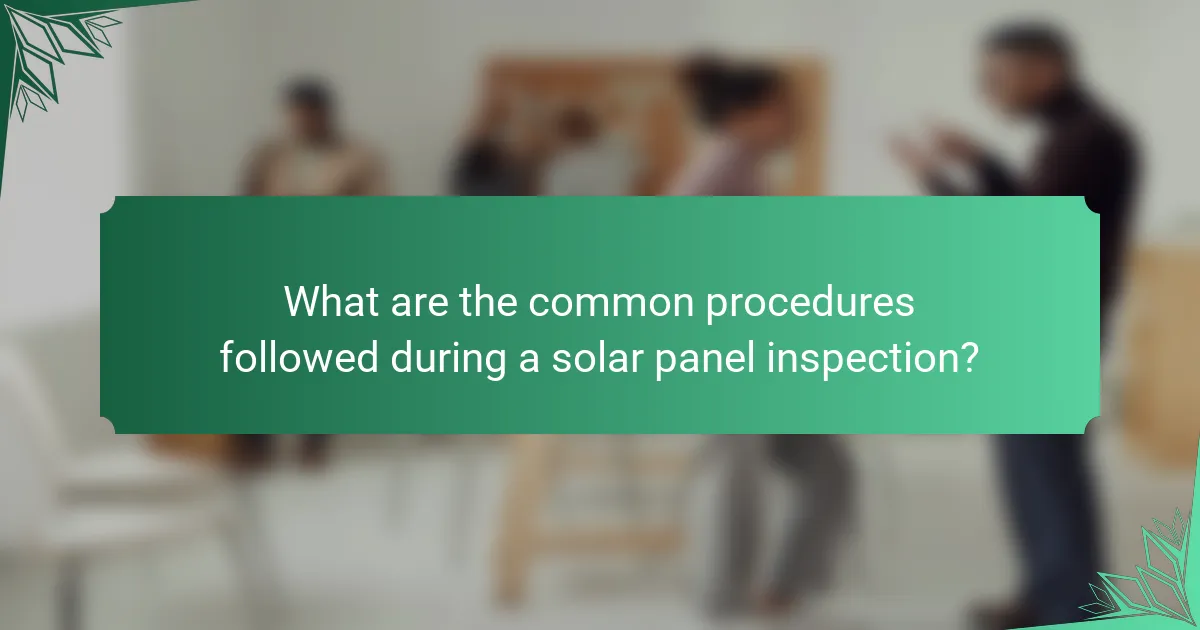
What is Solar Panel Inspection Frequency and Procedures?
Solar panel inspection frequency typically occurs annually. Inspections may also be conducted after severe weather events. The procedures involve visual checks for physical damage. Technicians assess electrical connections and ensure proper functioning. Cleaning the panels is part of the maintenance process. Performance monitoring through system alerts is essential. Regular inspections help identify issues early. This proactive approach can extend the lifespan of the solar panels.
Why is regular inspection of solar panels important?
Regular inspection of solar panels is important to ensure their optimal performance and longevity. Inspections identify issues such as dirt, debris, or damage that can reduce efficiency. A study by the National Renewable Energy Laboratory found that unmaintained panels can lose 20% of their efficiency over time. Regular checks help in early detection of potential problems, preventing costly repairs. Additionally, consistent inspections can extend the lifespan of solar panels by addressing wear and tear promptly. Regular maintenance can also ensure compliance with warranty requirements, protecting the investment. Overall, inspections are crucial for maintaining energy production and maximizing return on investment.
What potential issues can arise from infrequent inspections?
Infrequent inspections of solar panels can lead to several potential issues. These may include undetected damage, which can result in decreased efficiency. Additionally, accumulated dirt and debris can obstruct sunlight, further lowering energy production. Infrequent inspections can also cause minor issues to escalate into major repairs, increasing costs. Furthermore, lack of regular maintenance may void warranties provided by manufacturers. Safety hazards can arise from electrical issues that go unnoticed. Overall, the performance and lifespan of solar panels can be significantly compromised by infrequent inspections.
How does inspection frequency impact solar panel efficiency?
Increased inspection frequency positively impacts solar panel efficiency. Regular inspections help identify and address issues like dirt accumulation, shading, and equipment malfunctions. These factors can significantly reduce energy output. A study by the National Renewable Energy Laboratory found that panels cleaned and inspected quarterly performed 15% better than those inspected annually. Timely maintenance ensures optimal performance and longevity of solar systems.
How are solar panel inspections typically conducted?
Solar panel inspections are typically conducted through a systematic evaluation of the solar energy system. Inspectors assess the physical condition of the panels, wiring, and mounting structures. They check for any visible damage, dirt accumulation, or shading issues. Thermal imaging may be used to identify hot spots that indicate malfunctioning cells. The electrical connections are tested to ensure proper operation and safety compliance. Inspectors also verify the inverter’s functionality and performance metrics. Regular inspections help maintain efficiency and prolong system lifespan. Data shows that routine inspections can enhance energy output by up to 20%.
What are the standard procedures for inspecting solar panels?
The standard procedures for inspecting solar panels include visual inspections, electrical testing, and performance monitoring. Visual inspections involve checking for physical damage, dirt accumulation, and proper installation. Inspectors look for cracks, discoloration, or loose connections. Electrical testing measures the voltage and current output of the panels. This ensures that they are functioning within expected parameters. Performance monitoring uses data from the solar inverter to track energy production over time. Regular inspections should occur at least once a year, according to industry standards. These procedures help maintain efficiency and prolong the lifespan of solar panels.
What tools and equipment are commonly used during inspections?
Common tools and equipment used during inspections include multimeters, infrared cameras, and visual inspection tools. Multimeters measure voltage, current, and resistance in solar panels. Infrared cameras detect hot spots and thermal anomalies that indicate potential issues. Visual inspection tools, such as magnifying glasses and inspection mirrors, help assess physical damage and cleanliness. Additionally, safety gear like harnesses and helmets ensures inspector safety during roof access. These tools are essential for identifying performance issues and ensuring solar panel systems operate efficiently.

What factors influence the frequency of solar panel inspections?
The frequency of solar panel inspections is influenced by several factors. These factors include the local climate conditions, which can affect the wear and tear on the panels. For instance, areas with heavy snowfall or frequent storms may require more regular inspections. The installation environment also plays a role; panels installed in dusty or polluted areas accumulate debris faster, necessitating more frequent checks. Additionally, the age of the solar panel system impacts inspection frequency; older systems generally require more maintenance. Lastly, any reported performance issues or irregularities can trigger inspections to ensure optimal functioning. Each of these factors contributes to determining how often solar panel inspections should occur.
How do environmental conditions affect inspection needs?
Environmental conditions significantly influence solar panel inspection needs. Factors such as weather, pollution, and geographical location affect panel performance and degradation. For instance, panels in areas with high dust levels require more frequent inspections to ensure optimal efficiency. Rainy climates may lead to water accumulation, necessitating checks for potential damage. Additionally, extreme temperatures can cause thermal stress, prompting closer monitoring. Research indicates that solar panels in coastal regions face higher corrosion risks due to salt spray. Thus, tailored inspection schedules based on local environmental conditions enhance maintenance effectiveness.
What role does geographical location play in inspection frequency?
Geographical location significantly influences inspection frequency for solar panels. Areas with extreme weather conditions, such as heavy rainfall or snow, require more frequent inspections. This is due to the increased likelihood of damage from environmental factors. Additionally, locations with higher dust or pollen levels may necessitate regular cleaning and checks to maintain efficiency. For instance, solar panels in desert regions may accumulate dust quickly, requiring more frequent inspections compared to those in coastal areas. Furthermore, local regulations and incentives can dictate inspection schedules, adding another layer of variability. Overall, the geographical context directly impacts how often solar panels are inspected to ensure optimal performance.
How do weather patterns impact solar panel performance and maintenance?
Weather patterns significantly impact solar panel performance and maintenance. Solar panels generate more electricity in sunny conditions. High temperatures can reduce efficiency, causing panels to operate less effectively. Rain helps to clean panels, improving performance. However, heavy snowfall can obstruct sunlight, decreasing energy production. Wind can also affect panels by removing debris but may cause wear over time. Regular maintenance is necessary to address weather-related damage. For instance, inspections after storms can identify issues like loose connections or physical damage. Studies show that optimal performance requires understanding local weather trends.
What are the recommended inspection schedules for different systems?
Recommended inspection schedules for solar panel systems typically include biannual inspections. These inspections assess the overall condition and performance of the panels. Regular checks help identify issues like dirt accumulation or physical damage. In addition to biannual inspections, a thorough annual inspection is advised. This annual review should include electrical system checks and inverter assessments. Seasonal inspections may also be beneficial in regions with heavy snowfall or storms. These schedules ensure optimal performance and longevity of solar systems. The National Renewable Energy Laboratory recommends these frequencies for effective maintenance.
How often should residential solar panels be inspected?
Residential solar panels should be inspected at least once a year. Regular inspections help identify any potential issues early. This frequency is recommended by solar energy experts and manufacturers. Annual inspections can ensure optimal performance and longevity of the system. Some homeowners may choose to inspect more frequently after severe weather events. Dust, debris, and shading can impact efficiency. Regular maintenance can also help in keeping warranties valid. Following these guidelines can maximize energy production and system reliability.
What inspection frequency is advised for commercial solar installations?
Commercial solar installations are advised to undergo inspections at least once a year. This annual inspection ensures that the system operates efficiently and safely. Additionally, inspections should be conducted after severe weather events. Regular maintenance checks can identify potential issues early. These practices help in maximizing energy production and prolonging system lifespan. Industry standards recommend this frequency to comply with safety regulations. Following these guidelines can prevent costly repairs and downtime.

What are the common procedures followed during a solar panel inspection?
Common procedures during a solar panel inspection include visual checks, electrical testing, and performance analysis. Inspectors visually assess the panels for physical damage, dirt, or debris. They examine mounting systems for stability and alignment. Electrical testing involves checking connections, voltage output, and current flow. Performance analysis compares the system’s output to expected performance metrics. Inspectors may also review monitoring data for anomalies. These procedures ensure the solar panel system operates efficiently and safely. Regular inspections can identify issues early, potentially saving costs on repairs.
What specific aspects are analyzed during an inspection?
During a solar panel inspection, specific aspects analyzed include panel condition, electrical connections, and mounting integrity. Inspectors check for physical damage like cracks or discoloration on the panels. They also assess the cleanliness of the panels, as dirt can affect performance. Electrical connections are examined for signs of corrosion or loose wiring. The mounting system is evaluated to ensure stability and proper alignment. Additionally, the inverter’s functionality is tested, as it is crucial for converting solar energy. These aspects are essential to ensure the solar system operates efficiently and safely.
How is the physical condition of solar panels assessed?
The physical condition of solar panels is assessed through visual inspections and performance testing. Visual inspections identify physical damage, such as cracks or discoloration. Technicians check for debris, dirt, or shading that may affect efficiency. Performance testing involves measuring the energy output of the panels. This is compared to expected performance metrics based on manufacturer specifications. Infrared thermography can detect hot spots indicating malfunctioning cells. Regular assessments help maintain optimal energy production and extend the lifespan of solar panels.
What performance metrics are evaluated during the inspection process?
The performance metrics evaluated during the inspection process of solar panels include energy output, efficiency, and physical condition. Energy output measures the amount of electricity generated compared to expected levels. Efficiency assesses how well the solar panels convert sunlight into electricity. Physical condition examines the structural integrity and cleanliness of the panels. These metrics help identify issues that could affect performance. Regular evaluations ensure optimal functionality and longevity of solar energy systems.
What are the best practices for conducting solar panel inspections?
The best practices for conducting solar panel inspections include regular visual assessments and performance monitoring. Inspectors should check for physical damage, debris, and shading that may affect efficiency. Cleaning the panels is essential to maintain optimal energy production. Inspectors must verify electrical connections and ensure that wiring is intact. They should also assess the inverter’s performance and check for any error codes. Using thermal imaging can help identify hotspots that indicate potential issues. Regular inspections should occur at least twice a year to ensure system reliability. Adhering to manufacturer guidelines enhances the effectiveness of inspections.
How can solar panel owners prepare for an inspection?
Solar panel owners can prepare for an inspection by ensuring their system is clean and accessible. Cleaning the panels removes dirt and debris that may affect performance. Inspectors need clear access to the inverter and electrical connections. Owners should check for any visible damage or wear on the panels and mounting hardware. Additionally, reviewing the system’s performance data can highlight any potential issues. Having documentation of maintenance and previous inspections readily available is also beneficial. This preparation helps facilitate a smoother inspection process.
What common mistakes should be avoided during solar panel inspections?
Common mistakes to avoid during solar panel inspections include overlooking physical damage. Inspectors should thoroughly check for cracks or dents. Neglecting to clean the panels can reduce efficiency. Dirt and debris accumulation obstruct sunlight exposure. Failing to inspect electrical connections is another critical error. Loose or corroded connections may lead to system failures. Ignoring shading issues can also impact performance. Trees or buildings that block sunlight should be noted. Lastly, not documenting findings properly can hinder future inspections. Accurate records are essential for ongoing maintenance and troubleshooting.
What are the key takeaways for effective solar panel maintenance?
Regular cleaning of solar panels is essential for optimal performance. Dirt and debris can reduce efficiency by up to 25%. Inspect panels for damage or wear every six months. Look for cracks, loose connections, or corrosion. Ensure that the inverter and wiring are functioning properly. Monitor energy output to identify any performance drops. Keep surrounding vegetation trimmed to prevent shading. Document maintenance activities for future reference. Following these practices can extend the lifespan of solar panels and enhance energy production.
How can regular inspections enhance the lifespan of solar panels?
Regular inspections can significantly enhance the lifespan of solar panels by identifying issues early. These inspections help detect physical damage, dirt accumulation, or electrical faults. Early detection allows for timely repairs, preventing further deterioration. According to the National Renewable Energy Laboratory, proper maintenance can extend solar panel life by 25 years or more. Regular checks ensure optimal performance, maximizing energy output. Monitoring systems can also be evaluated for efficiency during inspections. This proactive approach reduces the risk of costly replacements. Overall, consistent inspections contribute to the longevity and reliability of solar energy systems.
What resources are available for solar panel owners to ensure proper maintenance?
Solar panel owners can access several resources for proper maintenance. These include manufacturer guidelines, which provide specific maintenance instructions. Online forums and communities offer shared experiences and advice from other solar panel owners. Local solar installation companies often provide maintenance services and consultations. Additionally, educational websites and videos teach best practices for solar panel upkeep. Mobile apps can help track performance and maintenance schedules. Government resources may offer incentives and information on solar energy maintenance. Regular inspections by certified professionals are also recommended to ensure optimal performance.
The main entity of this article is solar panel inspection frequency and procedures. The article provides a comprehensive overview of the importance of regular inspections for solar panels, detailing recommended frequencies, standard procedures, and the impact of environmental conditions on maintenance needs. Key topics include the potential issues arising from infrequent inspections, the tools used during inspections, and best practices for maintaining solar panel efficiency and longevity. Additionally, it addresses how geographic location and weather patterns influence inspection schedules and procedures, ensuring optimal performance of solar energy systems.